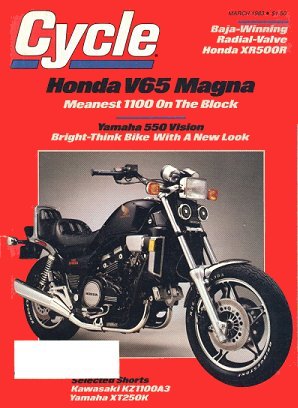

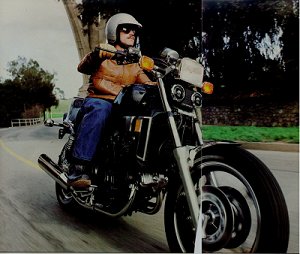
Honda
V65
Magna
Honda builds a motorcycle mean enough
for those guys who are tough enough to dip your heart out with a wooden
spoon
Don't be deceived. The 1100
Magna is not just another Special. Writing off the V65 as simply another
boulevard parade float is like calling a 10 inch switchblade a pocket knife.
It's true, but misses the point entirely. The term "Special" suggests highly
styled motorcycles that go limp wristed when it's time to perform. But the V65
is a urban streetfighter through and through, a bike that can kick almost
anything flat in a stoplight to stoplight brawl.
What
makes this Special so special? In a word, the engine. If you talk horsepower,
the Magna speaks your language. Its horsepower translates directly into an
immediate gut wrenching rush unmatched by any other production'. street machine.
To a man, the cycle staff raved about the engine. With its wonderfully potent
and flexible powerplant, this big four is a strong and willing worker that hums
along happily at 1500 rpm or sings fortissimo at the 10,000 rpm redline. The
best part of the V65 is a mid range punch that would do justice to Larry Holmes.
Whack the throttle open at 5000 rpm in first gear and the front wheel claws for
the sky while the Magna catapults forward. These antics are interesting enough
when you’re mounted on an open class motocrosser but when a 589 pound motorcycle
with a wheelbase of nearly 63 inches takes off like a carrier based F-14, it
gets your full attention.
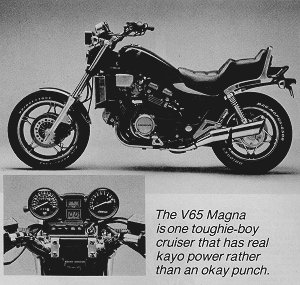
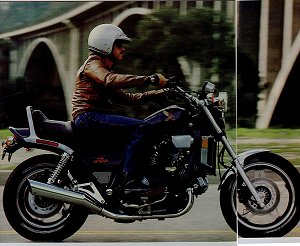 Honda built the V65 engine with technology carried over from the
V45, but the big Magna has all new hardware,. it shares no parts with the 750s.
Though the designs are virtually identical, everything has been scaled to 1100cc
specs.
Honda built the V65 engine with technology carried over from the
V45, but the big Magna has all new hardware,. it shares no parts with the 750s.
Though the designs are virtually identical, everything has been scaled to 1100cc
specs.
The V65 benefits from Honda's extremely compact Vee
engine design; at 17.4 inches, the 1100's engine is barely an inch wider than
the narrow 750 V four. The Magna’s 90 degree Vee angla sets the two front
cylinders low and nearly horizontal, while the rear cylinders stand almost
vertical. This right angle configuration produces perfect primary balance, and a
short stroke limits secondary imbalances.
Finally, to
ensure the 1100 Magna's smoothness Honda completely rubber mounted the engine
Within the full cradle frame, following the practice of last year's 750s. End
result: a monster engine that's a pussycat to live with.
Except for the size
increase, the 1100's top end appears identical to the V45's. The cylinders are
an integral part of the upper case half, making the entire unit rigid. The
liners are cast in freestanding cylinders--the cylinders and jackets are not
connected to any sort of webbing.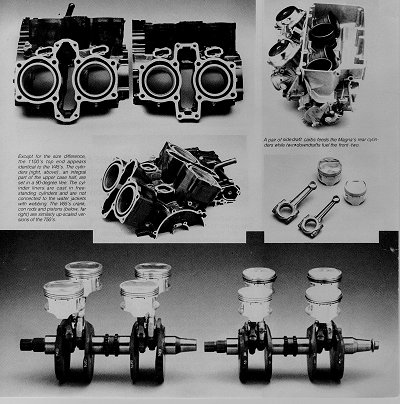 The highly oversquare 79.5 by 55.3mm engine
displaces 1098cc. Like the 750s, the 1100 uses a high 10.5:1 compression ratio;
it also incorporates similar anti-detonation features: water cooling to lower
combustion chamber and exhaust valve temperatures, a swirl inducing intake tract
that promotes quick burning of the fuel/air charge, and a carefully shaped
combustion chamber that concentrates most of the charge near the spark plug to
promote rapid flame travel. The 1100's 30mm intake and 26mm exhaust valves sit
in their four valve head at a narrow 38 degree included valve angle the V45's
intake and exhaust valve diameters are 26mm and 23mm
respectively.
The highly oversquare 79.5 by 55.3mm engine
displaces 1098cc. Like the 750s, the 1100 uses a high 10.5:1 compression ratio;
it also incorporates similar anti-detonation features: water cooling to lower
combustion chamber and exhaust valve temperatures, a swirl inducing intake tract
that promotes quick burning of the fuel/air charge, and a carefully shaped
combustion chamber that concentrates most of the charge near the spark plug to
promote rapid flame travel. The 1100's 30mm intake and 26mm exhaust valves sit
in their four valve head at a narrow 38 degree included valve angle the V45's
intake and exhaust valve diameters are 26mm and 23mm
respectively.
Each pair of cylinders has a set of dual
overhead camshafts to actuate the valves. The cams spin directly in the cylinder
head material in a plain bearing setup. A single cam lobe acting through a
forked follower equipped with screw type adjusters actuates each valve pair. A
silent type cam chain drives each set of cams, and an automatic chain tensioner
eliminates maintenance chores.
Straight cut gears transfer
the power from crank to clutch, the clutch gear a split, zero backlash type to
damp out gear whine. The clutch itself is hydraulically operated, an enlarged
version of, the VT750 V twin's rather than an upscaled version of the V45's.
The, V65's diaphragm clutch spring and clutch plates are larger in diameter than
the VT750's, and the 1100 holds two more plates than the Shadow. The diaphragm
spring clutch is more rugged than one of conventional design fitted in the same
space. Considering the abuse the V65 is likely to absorb during streetfights,
the diaphragm spring setup is indeed a good idea. As an anti-lockup device
during downshifting, the V65's clutch like the V twin's houses a one way sprag
clutch.
Vertically staggered transmission input and output
shafts reduce overall engine length; the output shaft lies below and aft of the
input shaft. Honda's six speed gearbox is unusual for an 1100cc bike. Because
the V 65's gear box was designed as a "five speed plus overdrive sixth
transmission;" top gear is really tall; calculated top speed in sixth works out
to 173 mph at the 10,000 rpm redline. At 60 mph the engine loafs along at 3460
rpm. Final drive is via a maintenance free shaft.
The
Magna carries its engine in a full cradle frame equipped with an air adjustable,
anti dive fork. Twin shocks adjustable for rebound and compression damping as
well as spring preload grace the rear. The 1100's wheelbase, a whopping 62.8
inches long, is less than a half inch under a Gold Wing's. This figure, combined
with the V65's rake and trail of 30.3 degrees and 4.1 inches, suggests the Magna
might be cumbersome and slow steering. Not true. Around town and in 'parking
lots the V65 handles just fine.
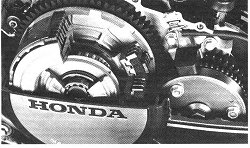 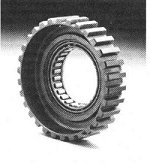 The VF1100's 700's clutch is an enlarged version of the VT750 V-twins, complete with a diaphragm spring, a one way sprag clutch and hydraulic actuation |
The VF1100 feels distinctly long and
unmistakably big, yet it requires only average steering effort through the
handlebar. The 31.6 inch high seat is not especially low, but the Honda still
feels fairly agile for an 1100. Honda engineers have done much to keep the
weight low in the bike-the basic engine design, of course, is instrumental. her
features such as the small under saddle gas tank contribute as well. Actually,
styling trimmed the main tank's volume, and the V65's under tank airbox and
filter also steal space from he main tank. The under seat tank and it’s fuel
pump were the answer.
Following Special styling, the
rider's portion of the two tiered seat is wide and well padded, although the
steep step confines the pilot's space. While most riders will find it adequate
for in town trolling, passengers get shortchanged; their pegs are too high, and
the narrow, firm rear portion of the seat has the comfort of a bird cage
bar.
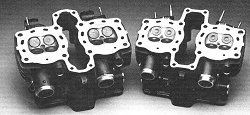  The 1100 head incorporates many of the 750 V four design concepts: the 38 degree included valve angle is the same and the combustion chamber is shaped to concentrate most of the fuel charge near the centrally located spark plug holes to promote rapid flame travel. Each cam lobe actuates a pair of valves via a forked follower equipped with screw type adjusters |
Once the rider enthrones himself in the
saddle, the pullback handlebar and the forward mounted footpegs define his
position. The pegs aren't as radical as the VT750C Shadow's, and that's good for
comfort and control ' Given the V65's eyeball flattening acceleration, a riding
position mimicking a tipped back rocking chair would be dangerous. The forward
mounted pegs are convenient if you’re paddling the V65 around a parking lot, and
while the bar has two way adjustability, it has, too much pullback to please our
staff.
Although the riding position may be a strong
selling point on the showroom floor and a viable stance for stoplight to
stoplight warfare, the bike's ergonomics offer the rider very little support, at
freeway speeds. Arm, back and stomach muscles must position him against the
windstream. This sort of onboard isometrics is no sweat for short hops. After 30
minutes though especially if you're riding at supra legal speeds you'll feel as
though you’ve been working overtime at your Nautilus club. Although long legged
riders can use the passenger pegs for, a brief change in position, the reach
back leaves their legs nearly folded double in the process. Shorter riders can't
reach the rear pegs at all. For them, a radical forward crouch proves most
effective, though it places their torsos at an awkward angle and their faces
mere inches from the handlebar. Short of changing the bar/seat/peg
relationships, the best remedy is to ride in half hour
spurts.
In a somewhat surprising move, Honda equipped the
VF1100 with suspension components biased for sport riding. The up and down
torque reaction of shaft driven bikes forces manufacturers to make trade offs
when selecting rear suspension components. Typically, light spring and damping
rates provide a soft, cushy ride at the expense of backroad handling, while a
taut, well damped rear suspension makes fast riding easier and steadier at the
expense of slow cruising comfort. Adjustable shock damping and air adjustable
springing usually provide an effective, albeit expensive, compromise that gives
a rider latitude in setting his bike up for specific
tasks.
The Magna's rear shocks have state of the art
adjustability: two way adjustable compression damping and four way adjustable
rebound damping. The springing is not air adjustable, and Honda engineers
selected spring rates that are decidedly stiff. Our heavier (185 pound) testers
found the rear end firm, but acceptably soft for freeway cruising when the
springs were set at minimum preload. Lighter testers found the ride stiff and
harsh, and the riding position tends to exacerbate this assessment. The
reclining riding position centers most of the rider's weight back toward the
tailbone, and every bump and seam in the road transfers a sharp jolt directly to
the rider's spine.
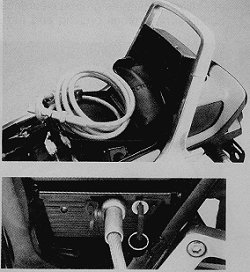 Honda's FOIL ant theft System uses an integrated cable alarm setup, if the cable is cut, the alarm sounds. Cable fits neatly in the tail compartment. |
For backroad riding, Honda's choice of
sporting shocks pays off handsomely. Set up stiffly, the VF's suspension damps
well over all types of road surfaces, from fast sweepers to slow, knotty
corners; however, the air adjustable fork flexes perceptibly when winding
through unusually bumpy sweepers. The Magna's triple disc brakes offer excellent
feel and stopping power, and the anti dive valving effectively preserves ground
clearance during simultaneous braking and turning. The 1100 offers a good amount
of ground clearance, and the stiff rear end does a good job of controlling the
shaft drive's up and down motions. The stylishly wide tires put a big patch of
rubber on the road.
On twisting roads as well as around
town, the 1100 requires only a moderate amount of steering effort. Nice.
However, when you're busting along hard on curvy roads, the Magna feels
disconcertingly vague through the handlebar. Several factors may contribute to
this feeling. First, the V65's seat and controls push the rider's weight more
rearward than on a sporting bike. On a sport bike a frisky riding pilot
naturally moves himself even more forward than normal, applies weight to the
bars, and rides with the balls of his feet on the pegs. It's an active riding
position. In fast going the Magna's more passive position does little for rider
confidence. Our staffers didn't like the bar - we felt as if we were steering
the V65 with a tiller. Second, the V65's percentage of weight distribution (dry
and unladen) is 45 front/55 rear (the CB1100 F's is 49 front/51 rear), and it's
reasonable to assume that the V65 rider would bias that distribution even more
toward the rear - though what makes the front tire stick in corners is more
complex than where the weight is. Third, the V65 engine punches so hard out of
corners that the front end naturally will feel light under acceleration. And
there's nothing like horsepower to quicken up the steering of any bike. In more
practical terms, you'll have to go riding with your friends and their full
sporting 1100s only once to decide you won't clean up on them when the roads get
twisty.
The Magna's brute torque and mile wide power
spread make the bike a joy to ride. With a little deft clutch work, the VF will
idle away from a dead stop, even carrying two riders, without so much as a blip
of the throttle. That's low end torque! Still, the engine revs readily up to
redline, and it's all too easy to send the tach needle deep into
the red zone
because the bike runs so smoothly. When you cruise the 1100 in freeway traffic,
everybody else seems to be poking along, clogging the road at a snail's pace.
But a quick glance at the instruments explains the situation; thanks to the tall
gearing, strong engine and smooth ride you're cruising at 80 mph or more. Riders
must make a conscious effort to observe the legal limit. Passing in top gear is
effortless, but if you want to swoop by cars with authority, dropping down to
fifth or even fourth delivers passes in an eye blink or two.
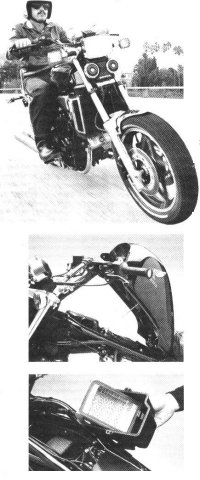 A It up tank provides access to the air filter. Working conditions are cramped. The paper filter requires changing only every 8000 miles. |
We paid for our right handed excesses
with mediocre mileage results. Steady cruising netted figures in the Iow 40 mpg
range, but our average fuel consumption rate worked out to an un-spectacular
36.1 mpg. The low fuel warning indicator, which lights up when only 0.8 gallon
remains in the 4.5 gallon tank, usually winked on after about 135 miles, giving
the rider about 30 miles to find a gas station; the Magna has no reserve
capacity.
Our Magna started easily on chilly mornings, and
the handlebar mounted choke lever is conveniently located for left hand
adjustment. The Honda runs happily after minimal warm up and carburets well, hot
or cold, under all engine conditions.
The hydraulic clutch actuating setup
eliminates any need for lever adjustment, and gives good clutch engagement and
feel. Clutch pull is moderately stiff, considerably stiffer than the
VT750's.
The six speed gearbox is a wonderful luxury
though not really necessary, thanks to the broad powerband and smooth engine.
The 700 rpm drop in engine speed between fifth and sixth gears at 60 mph is
welcome for straight line cruising. The gearbox proved a reluctant shifter,
especially when the engine was cold; slow, deliberate shifting is the best way
to combat this quirk.
This king size Magna exhibits some
bothersome driveline snatch. Gearplay in the drive train, combined with the CV
carb's tendency to snap the carb slides open and closed, accentuates the Magna's
low speed jerk and lurch routine. Long stints of stop and go traffic become
irksome, and in congested, slow moving traffic, riders can skirt the problem by
shifting to a higher gear and idling along slowly.
The
Magna has a number of attractive standard features. They include an LCD gear
position indicator, microprocessor controlled self cancelling turn signals, and
FOIL, Honda's built in security cable/alarm system. Last year, FOIL was the
exclusive feature of the V45 Sabre. We think the V65's engine and its
streetfighter styling make the King Kong Magna motorcycling's prime candidate
for Midnight (and sometimes Daylight) Liberation Forces. Honda's fiber optic
security cable is pretty innovative and probably offers as much protection as
one can reasonably expect.
For sheer visceral attraction,
nothing beats the 1100 engine. By far, it's the V65's best feature, and
motorcyclists who buy the V65 on looks will quickly find themselves enchanted by
the 1100's performance. The 65's power is irresistible. The 1100 Vee would make
an ideal starting point for a full fledged, pavement ripping sport bike; and
while the VF750F Interceptor is a gorgeous piece, the 750 can't have 1100 punch.
You have to wonder how many ways Honda can find to use the V65. A VF1100F is an
obvious possibility, and the 1100's broad powerband, six speed gearbox,
driveshaft and excellent vibration control also make the V65 a wonderful
platform on which to build a full dresser. But for now, Honda has taken its
premier performance engine to the streets to create a stoplight to stoplight
blockbuster extraordinaire.
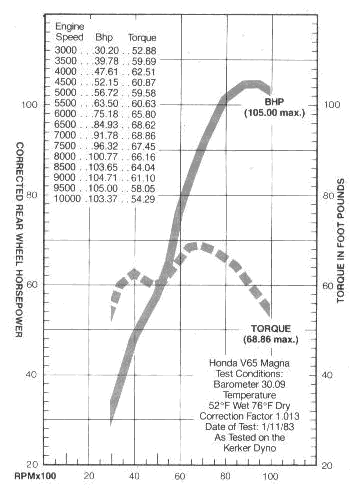 THE TEN SECOND
BATTLE THE TEN SECOND
BATTLEHonda's V65 Magna is an authentic 10 second motorcycle We re sure of it but unofficially so Readers following the battle of the 10 second quarter know that the GPz1100 tested by Cycle last month ran 10 91. The Honda 1100F hovered at the 10 second threshold in January but didn't quite make it. Honda was confident, though, that the V65 Magna was a 10 second jet, and there was plenty of evidence pointing in that direction. First, John Gleason, professional quarter mile pilot, had taken the V65 Magna into the tens for Honda, a feat well publicized by the company. Second, Honda had every reason to believe that the Magna would turn out to be a 10 second bike in Cycle's hands - Mark Homchick (out of real curiosity) had run a pre production V65 through the traps at 11.06 seconds long before the magazine's test unit, a line production bike, showed up for evaluation. Before Homchick could get our test Magna to the strip, he became the proud owner of an unwanted accessory: a plaster cast running from thumb to armpit. The cast had (and still has) optional features - stainless steel pins to immobilize a left wrist broken in a number of places and pieces. It was a bad break for Honda, too. As explained in February, it takes a deft touch to get a Superbike into the tens; only two or three journalists can, and MH is our quota. Honda had the weapon; Cycle, the broken trigger finger. On the one hand, Cycle couldn't officially consider any quarter mile times outside the ones turned in by staffers. On the other hand, Mark's performance with 10 second motorcycles is much closer to John Gleason's than to other staff members'. If Gleason could take our test V65 Magna and put it well into the tens, it would clearly indicate that the V65 would be a 10 second bike in Mark's hands. And that would give our readers a much fairer picture of the Magna's performance than if we published an 11.3 figure generated by Buzz Buzzelli. Gleason turned in a 10.84 second, 124.82 mph shot with the Magna. That's about 0.04 second quicker than he managed on the GPz1100 while coaching Homchick on ten second riding. The total run of Gleason's times on our test unit V65 were as follows: 11.29 @ 120.48; 11.14 @ 124.82; 11.13 @ 124.48; 10.92 @ 124.48; 10.87 @ 125.17; 10.91 © 125.17; 10.86 @ 125.00; 10.90 @ 124.65; 10.95 @ 124.30; 10.91 @ 124.82; 10.84 @ 124.82. The Honda V65 is easier to ride at the strip than the GPz1 100 because the Magna has more mid range punch - note the dyno charts. This means it gets off the line more easily. Furthermore, most street riders will have the impression that the Honda is a lot stronger than the GPz1100 because of the V65's hellacious mid range power. And that's a fact. The V65 shows more horsepower than the GPz at every rpm level on the dyno charts, and the power is more broadly distributed. At the very top the V65 produces 105 horsepower at the rear wheel, a touch more than the 104 horse GPz. Only at 8500 rpm does the GPz edge above the Monster Magna. At 3500 rpm, for example, the V65 has an additional 10 pounds feet of torque. At 4000 rpm the V65 has over 10 horsepower and 14 pounds-feet on the GPz 1100. The V65 is, by a mile, the strongest stocker we've bolted to the dyno. Though most riders might find the Honda easier to deal with in the quarter, be as sured that getting a 10 second motorcycle into the tens is tough. If you doubt that, pay a visit to your local drag strip. Unofficially, the V65 is a 10 second bike. Officially, it's the Horsepower King. You can take those numbers to the bank and deposit them. When Mr. Pins and Plaster Homchick mends, we want to run our V65 Magna again to get our official figures. At that time, we'd like to gather all the 10 second contenders for a little high drama around the old drag strip Christmas tree. We can hardly wait. |
|
Make and model |
Honda VF1100C Magna |
|
Price, suggested retail (as of 12/2/82) |
$3898 |
|
Perfomance |
|
|
Standing start 1/4 mile |
10.84 sec. @ 124.82 mph (see text) |
|
Engine rpm @ 60 mph, top gear |
3460 |
|
Average fuel consumption rate |
36.1 mpg (15.3 km/1) |
|
Cruising range |
162 mi. (261 km) |
|
Load capacity (GVWR less curb weight) |
371 lbs. (168 kg) |
|
Maximum speed in gears @ engine redline |
(1) 57 (2) 80 (3) 101 (4) 121 (5)145 (6)173 |
|
Engine |
|
|
Type |
Four-stroke, 90-degree V-four; liquid-cooled with dual chain-driven overhead camshafts; four valves per cylinder |
|
Bore and stroke |
79.5 x 55.3mm (3.13 x 2.18 in.) |
|
Piston displacement |
1098cc (67.0 cu. in.) |
|
Compression ratio |
10.5:1 |
|
Carburetion |
(4) Keihin 36mm constant-vacuum |
|
Exhaust system |
Four-into-two |
|
Ignition |
Battery-powered, inductive, magnetically triggered |
|
Air filtration |
Paper element, disposable |
|
Oil filtration |
Paper element, disposable |
|
Oil capacity |
3.7 qts. (3.5 1) |
|
Bhp @ rpm |
105.00 @ 9500 |
|
Torque @ rpm |
68.86 @ 7000 |
|
Transmission |
|
|
Type |
Six-speed, constant-mesh, wet-clutch |
|
Primary drive |
Straight-cut gear; 70/41; 1.71 |
|
Secondary drive |
Helical-bevel gear; 18/17; 1.06 |
|
Final drive |
Shaft and bevel gear; 35/1 1; 3.18 |
|
Gear ratios (transmission) |
(1) 39/17, 1.71 (2)34/21.1.62 (3)31/24,1.29 (4) 29/27, 1.07 (5) 26/29, 0.90 (6) 24/32, 0.75 |
|
Gear ratios (overall) |
(1) 13.20 (2) 9.31 (3) 7.43 (4)6.18 (5)5.16 (6)4.31 |
|
Chassis |
|
|
Type |
Double-downtube, full-cradle frame; tube/box-section steel swing arm |
|
Suspension, front |
Leading-axle, air-assisted fork with 41 mm tubes, anti-dive valving and 5.9 in. (150mm) of travel |
|
rear |
(2) shock absorbers, adjustable for spring preload and rebound and compression damping, producing 4.1 in. (105mm) of rear-wheel travel |
|
Wheelbase |
62.8 in. (1595mm) |
|
Rake/trail |
30.3/4.1 in. (105mm) |
|
Brake, front |
Hydraulic, dual-disc with twin-piston calipers |
|
rear , |
Hydraulic, single-disc with twin-piston caliper |
|
Wheel, front |
Cast, 2.50 x 18 |
|
rear |
Cast, 3.00 x 16 |
|
Tire, front |
110/90-18 Bridgestone Mag Mopus-L303 |
|
rear |
140/90-16 Bridgestone Mag Mopus-G508 |
|
Seat height |
31.6 in. (803mm) |
|
Ground clearance |
5.9 in. (150mm) |
|
Fuel capacity |
4.5 gals. (17.0 1) |
|
Curb weight, full tank |
589.0 lbs. (267.2 kg) |
|
Test weight |
749.0 lbs. (339.7 kg) |
|
Electrical |
|
|
Power source |
Three-phase AC generator, 300 watts |
|
Charge control |
Solid-state voltage regulator |
|
Headlight beams, high/low |
60/55 watts |
|
Tail/stoplights |
8/27 watts |
|
Battery |
12V 18AH |
|
Instruments |
|
|
Includes |
Speedometer, odometer, tripmeter, tachometer with 10,000-rpm redline. Coolant temperature gauge; indicators for gear position, tail/stoplight burned out, low oil pressure, low fuel level, high beam, turn signals, neutral |
|
Speedometer error |
|
|
30 mph indicated, actual |
29.52 mph |
|
60 mph indicated, actual |
57.69 mph |